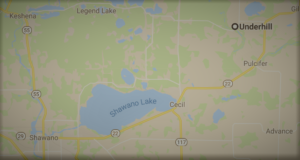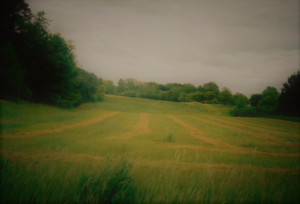
The map shows the town of Shawano west of the lake of the same name. Northeast of the lake is a small village, Underhill, by the Oconto River. Another town, Pulcifer, is a little further south, where the Icelandic post office was in the colony. It was north and west of Pulcifer.
Shawano County: For centuries, indigenous peoples have taken advantage of the benefits of what is now Shawano County. In the middle of the 19th century, immigrants of various origins sought settlement in the area and engaged in logging. The name is from the indigenous language, some say it from the Ojibwa language and means “tropical or southern”, and the county is exactly at the southernmost border of this region. One of the chiefs of the Menominee nation was named Sawanoh. The name remained for the lake and the county when it was created in 1853 but the spelling was then Shawanaw County. This was then changed in 1856 to its current spelling. In those years the population was about 250, but by 1870 it had increased to over three thousand.

Stephan G. Stephansson and his father took land together. The picture shows part of it. Photo JÞ. An excellent description of the settlement in Shawano can be found in Viðar Hreinsson’s book, Landneminn mikli
Icelandic settlement: Páll Þorláksson (see him) had received a group of his countrymen in Quebec, Canada in 1873 and went with them from there to Wisconsin. He had agreements with Norwegian farmers to take in Icelandic families and individuals for some time. He did this so that his countrymen learned necessary practices before they began to study lands and start farming on their own. In the spring of 1874, some were becoming impatient; people desperately wanted to go live on their own and sought out Páll for a solution. He had been studying theology in St. Louis during the winter but came to Milwaukee where his brother Haraldur and their father Þorlákur decided to explore land in the north of the state. They came to Shawano and looked as well. Páll thought the name of the lake meant Ljósavatn, which they did not think was bad, as they were all from Ljósavatnshreppur in Iceland. The name is attached to the settlements of Icelanders there. Páll consulted with Norwegian and German priests who had close ties with Norwegian and German denominations in the United States. At a meeting with the county committee in August, Páll succeeded in getting it agreed that Icelandic immigrants who wanted to settle in the county would get their lands at half price. Furthermore, it was agreed that an individual could not claim more than 80 acres. Agreements were also reached on access to rather poor, sandy land to be given to Icelanders for sheep farming, but it was considered very poor land for agriculture and therefore of little value. When the agreements were in place, people began to move away from various Norwegian settlements to the Promised Land in Shawano County. Family fathers strived to study land and build huts on it, but young men and single people sought work in the county, many by logging.
Congregation: Páll Þorláksson completed his theological studies at the seminary of the German denomination, Missouri Synod, in St. Louis in the spring of 1875 and was ordained a pastor in the summer and began working for the Norwegian congregation in Shawano. He decided to establish an Icelandic congregation in the fall and was called “The Icelandic Lutheran Congregation in Shawano County,” and 35 members were registered at the founding. (See list in Employment / Priests and churches.) This was the first Icelandic congregation established in North America. One of the first works of Reverend Páll in the new congregation was to baptize the daughter of his brother Haraldur and his wife, María Stefanía Sigurðardóttir, who was born on September 21, 1875 and was the first child born in the Icelandic settlement in Shawano County. She was given the name María Lovísa.
English version by Thor Group
